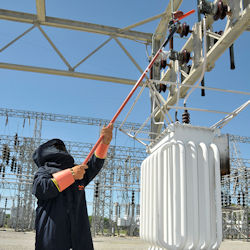Working Near Overhead High-Voltage Lines and Equipment
Overhead and buried power lines at your site are especially hazardous because they carry extremely high voltage.
Fatal electrocution is the primary risk, but burns and falls from elevations are also hazards. Using tools and equipment that can contact power lines increases the risk. Examples of equipment that could contact power lines:
- aluminum paint rollers
- backhoes
- concrete pumpers
- cranes
- long-handled cement finishing floats
- metal building materials
- metal ladders
- raised dump truck beds
- scaffolds
Real-Life Accident
Seven employees of a masonry company were erecting a brick wall from a tubular, welded-frame scaffold approximately 24 feet high. The scaffold had been constructed only 21 horizontal inches across from a 7,620-volt power line. A laborer carried a piece of wire reinforcement (10 feet long by 8 inches wide) along the top section of the scaffold and contacted the power line with it. The laborer, who was wearing leather gloves, received an electric shock and dropped the wire reinforcement, which fell across the power line and simultaneously contacted the metal rail of the scaffold, energizing the entire scaffold. A 20-year-old bricklayer standing on the work platform in contact with the main scaffold was electrocuted.
Knowledge Check Choose the best answer for the question.
4-6. What is the primary risk while working near power lines?
You forgot to answer the question!

